#Watershed development program
Text
Good News - June 1-7
Like these weekly compilations? Support me on Ko-fi or $Kaybarr1735! Also, if you tip me on Ko-fi or CashApp (and give me some way to contact you if it doesn’t automatically), at the end of the month I'll send you a link to all of the articles I found but didn't use each week!
1. Hundreds of Mayors, City Leaders Commit to Protecting Monarch Butterflies in Annual Pledge

“The 300 participating communities are taking a record number of actions to advance monarch conservation by planting or maintaining pollinator gardens at prominent locations, supporting native plant sales and giveaways, and partnering with local gardening organizations and experts to advance monarch conservation and community engagement.”
2. Basic income can double global GDP while reducing carbon emissions, analysis suggests
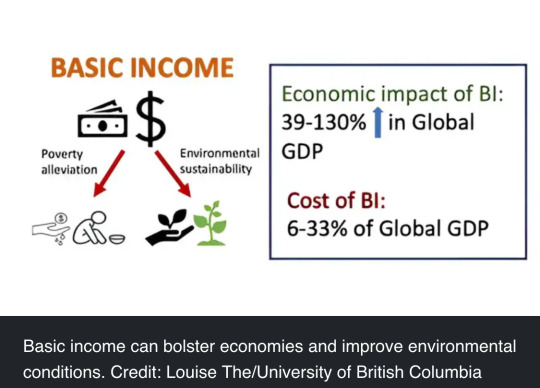
“Researchers suggest that charging carbon emitters with an emission tax could help fund such basic income programs while reducing environmental degradation. [… G]iving basic income to the entire world population could boost the global GDP by $163 trillion, which is about 130% of the current GDP. Every dollar spent on implementing basic income can generate as much as $7 in economic impacts, the analysis shows.”
3. Los Angeles-area wildlife crossing over freeway expected to be ready in 2026

“The crossing will be a vegetated overpass that will help isolated animals safely cross U.S. 101. […] Officials said the Wallis Annenberg Wildlife Crossing will "reconnect habitats and improve the health of the environment for many species in Southern California." They added that currently, U.S. 101 is a huge barrier that disconnects Southern California wildlife. […] “We need to move beyond mere conservation, toward a kind of environmental rejuvenation," [Annenberg] said in a statement. "Wildlife crossings are powerfully effective at doing just that — restoring ecosystems that have been fractured and disrupted.””
4. ‘Many waterfowl are very gay’: Elliot Page set to narrate LGBTQ+ animal documentary Second Nature

“According to Deadline, Second Nature will be executive produced by Page, who will also narrate the documentary set to explore instances of same-sex attraction in species other than humans. And, spoiler alert, they’re everywhere. [… Page said,] “Second Nature reveals the full spectrum of life and how when it comes to gender and sexuality in nature, the diversity is endless. I learned so much and am thrilled others will too.””
5. McKenzie River Restoration Benefiting Threatened Upper Willamette River Chinook

“Salmon have successfully reproduced at the Finn Rock restoration site in Oregon’s McKenzie River watershed. Another project aims to bring salmon back to lower Quartz Creek. […] Historical accounts document the presence of Chinook salmon and bull trout in Quartz Creek, but neither species has been seen there for decades. Project partners have replaced an aging bridge that constricted Quartz Creek. Previously, the stream constriction forced the water to gush like a fire hose, blasting salmon and sediment downriver. […] The restoration work will increase groundwater and expand the amount of wetlands, which can reduce the impact of forest fires.”
6. Leading Scholars Call for Global Treaty on Free Education

“According to the experts, well-established scientific evidence shows “unequivocally” that education is foundational to children’s healthy development and lifelong prospects[…. Seventy scholars from thirty countries] call on all governments to support a new optional protocol to the Convention on the Rights of the Child to ensure recognition of the right to free early childhood education and free secondary education, alongside the existing explicit right to free and compulsory primary education.”
7. Water is key as study shows restoration of drained tropical peat is possible

“Rewetting of tropical peatland that was drained for agriculture can lead to the recovery of the native ecosystem, a long-term study of a former pulpwood plantation in Indonesia shows. Researchers studying the 4,800-hectare (11,900-acre) plot that was retired in 2015 by Asia Pulp & Paper (APP) found the water table had risen, soil carbon emissions had gone down, and native trees were springing up and replacing the planted acacia pulpwoods.”
8. Antioxidant gel preserves islet function after pancreas removal: New approach could reduce diabetes complications

“Before surgeons remove the pancreas from patients with severe, painful chronic pancreatitis, they first harvest insulin-producing tissue clusters, called islets, and transplant them into the vasculature of the liver. […] Unfortunately, the process inadvertently destroys 50–80% of islets, and one-third of patients become diabetic after surgery. [… To] create a healthier microenvironment for the islets, the researchers adhered the islets to the omentum with an inherently antioxidant and anti-inflammatory biomaterial[…,] significantly improving survival and preserving function of transplanted islets.”
9. Restoring Indigenous aquaculture heals both ecosystems and communities in Hawai‘i

“The loko i’a system of native fishponds in Hawai‘i has for generations provided sustenance to Indigenous communities[….] Unlike commercial fish farms, loko i‘a thrive without feed input and need little management once established[….] “We are using science to translate ‘ike kupuna, or Indigenous knowledge, into policy,” said study co-author Kawika Winter […] “Loko i’a are really built to work with the ecosystem, whereas not all forms of aquaculture are made to do that.””
10. Meet Neo Px: the super plant that attacks air pollution

“Neo Px is a bioengineered plant capable of purifying indoor air at an unprecedented scale[….] "It's the equivalent of up to 30 regular houseplants in terms of air purification," said Lionel Mora, co-founder of startup Neoplants. "It will not only capture, but also remove and recycle, some of the most harmful pollutants you can find indoors." [… The plant comes] with packets of powder that contain a microbiome, essentially a bacterial strain. "This bacteria colonizes the plant's roots, soil and leaves [… and] absorbs the VOCs to grow and reproduce. The plant is there to create this ecosystem for the bacteria. So we have a symbiotic system between plants and bacteria.””
May 22-28 news here | (all credit for images and written material can be found at the source linked; I don’t claim credit for anything but curating.)
#hopepunk#good news#income inequality#basic income#los angeles#wildlife#habitat#elliot page#lgbtq#gay rights#nature#fish#salmon#river#california#agriculture#education#human rights#science#medicine#health#pancreatitis#diabetes#hawaii#monarch butterfly#butterfly#butterflies#butterfly migration#conservation#plants
31 notes
·
View notes
Text
In 2021, despite continued struggles during the COVID-19 pandemic, the number of Black-owned businesses grew by 14.3% from the year prior. This growth is a significant achievement in a landscape where Black individuals still own the lowest share of employer firms (firms with more than one employee) compared to every other racial group. The following year, Black median wealth grew, along with a 30% increase in employer firm revenue.
In the face of this progress, a litany of lawsuits combatting programs that intentionally fund Black-owned businesses is moving through the courts, emboldened by two watershed Supreme Court cases that ended affirmative action in higher education last year. The legal backlash against DEI (diversity, equity, and inclusion) initiatives has been swift, leaving a chilling effect across government, nonprofit, and private investment programs. For these investors, the question lingers: Is it still legal to invest in Black-owned businesses?
Responses from experts seem to be “yes,” but with some alternative strategies. Governments, philanthropists, banks, and businesses must use funding methods that pass legal scrutiny—and fortunately, many already exist. This report explains how tools such as special purpose credit programs, community development financial institutions, and placed-based investment—along with innovative funding models such as community ownership and crowdfunding—are all legal strategies funders can use to invest in Black businesses today.
6 notes
·
View notes
Text
Sandra Day O'Connor died Friday at the age of 93. She was the first woman to serve on the US Supreme Court. Although she was appointed by President Ronald Reagan, her approach was more centrist than his and she was often the swing vote on the court.
After her retirement from SCOTUS in 2006, President George W. Bush appointed the hard right Samuel Alito to replace O'Connor. In 2022 Alito was the driving force behind the dismantling of Roe v. Wade.
Justice O’Connor joined the controlling opinion in Planned Parenthood v. Casey, the 1992 decision that, to the surprise of many, reaffirmed the core of the constitutional right to abortion established in 1973 in Roe v. Wade.
To overrule Roe “under fire in the absence of the most compelling reason to re-examine a watershed decision,” she wrote in a joint opinion with Justices Anthony M. Kennedy and David H. Souter, “would subvert the court’s legitimacy beyond any serious question.”
Last year, the court did overrule Roe, casting aside Justice O’Connor’s concern for precedent and the court’s public standing. In his majority opinion in Dobbs v. Jackson Women’s Health Organization, Justice Alito wrote that Roe and Casey had “enflamed debate and deepened division.”
Justice O’Connor also wrote the majority opinion in Grutter v. Bollinger, a 2003 decision upholding race-conscious admissions decisions at public universities, suggesting that they would not longer be needed in a quarter-century. In striking down affirmative action programs in higher education in June, the Supreme Court beat her deadline by five years.
[ ... ]
Justice O’Connor was also an author of a key campaign finance opinion, McConnell v. Federal Election Commission in 2003. A few years after Justice Alito replaced her, the Supreme Court, by a 5-to-4 vote in 2010, overruled a central portion of that decision in the Citizens United case.nge?
A few days later, at a law school conference, Justice O’Connor reflected on the development.
“Gosh,” she said, “I step away for a couple of years and there’s no telling what’s going to happen.”
[ ... ]
She held the crucial vote in many of the court’s most polarizing cases, and her vision shaped American life for her quarter century on the court. Political scientists stood in awe at the power she wielded.
“On virtually all conceptual and empirical definitions, O’Connor is the court’s center — the median, the key, the critical and the swing justice,” Andrew D. Martin, Kevin M. Quinn and Lee Epstein and two colleagues wrote in a study published in 2005 in The North Carolina Law Review shortly before Justice O’Connor’s retirement.
Let this be a reminder that the direction of the Supreme Court depends on the President who appoints its members and the Senate which confirms them.
While we may not have warm and fuzzy feelings about Ronald Reagan, two of his three† appointments to SCOTUS were centrists. Of the six current justices appointed to the court by Republican presidents, one is a conservative and the other five are hardline reactionaries.
When voting for president or senator, we are indirectly also voting for SCOTUS justices who could be on the court for decades. We ought to keep that in mind when we hear people suggesting that we should cast "protest votes" for impotent third parties which have no chance of getting elected.
Remember that no 2024 Republican presidential candidate will nominate to the court somebody as relatively moderate as Sandra Day O'Connor.
† I count Rehnquist, who Reagan elevated from Associate to Chief Justice, as a Nixon appointee.
#sandra day o'connor#us supreme court#scotus#roe v. wade#the sanctity of reproductive freedom#samuel alito#republicans#election 2024
13 notes
·
View notes
Text

Libya’s Wadi al Qattarah
An astronaut aboard the International Space Station captured this nadir (downward-looking) photograph of the Benghazi district in northern Libya while orbiting over the Mediterranean Sea. This detailed photo, taken with a handheld camera using a long focal length lens, shows the Wadi al Qattarah and villages along its banks. The term wadi derives from Arabic and Hebrew and refers to an ephemeral riverbed that only holds water during the rainy season.
Cropland, desert, and built-up areas are visible in this image. The intensively cultivated and irrigated agricultural zone appears as clusters of dark-hued, square fields in the bottom half of the scene. This contrasts with the less developed area in the top half of the image used for livestock grazing and herding.
The image also shows a dam of the Wadi al Qattarah. This dam, together with the main dam to the northeast (out of frame), helps to control floods from the surrounding catchment area. The wadi’s valley, winding down the center of this image, carries water to the Mediterranean Sea on the west-northwestern side of Benghazi city (out of frame).
The dams and rivers in this area have a long history of flooding. This image was taken weeks before Storm Daniel struck Libya with intense rainfall on September 10, 2023, causing devastating floods in the northeastern cities. The storm originated from a low-pressure system that evolved into a tropical-like cyclone known as a medicane. In the city of Derna, about 230 kilometers (140 miles) northeast of this photo, flooding from the storm triggered the collapse of two dams, causing severe damage.
In past decades, the dams along the Wadi al Qattarah have also been damaged or destroyed, leading them to be rehabilitated or rebuilt. Today, they serve as an important protector of Benghazi against floods coming from the wadi and its watershed.
Astronaut photograph ISS069-E-61443 was acquired on August 17, 2023, with a Nikon D5 digital camera using a focal length of 1150 millimeters. It is provided by the ISS Crew Earth Observations Facility and the Earth Science and Remote Sensing Unit, Johnson Space Center. The image was taken by a member of the Expedition 69 crew. The image has been cropped and enhanced to improve contrast, and lens artifacts have been removed. The International Space Station Program supports the laboratory as part of the ISS National Lab to help astronauts take pictures of Earth that will be of the greatest value to scientists and the public, and to make those images freely available on the Internet. Additional images taken by astronauts and cosmonauts can be viewed at the NASA/JSC Gateway to Astronaut Photography of Earth. Caption by Wilfredo García López/Jacobs-JETS II Contract at NASA-JSC.
4 notes
·
View notes
Text
youtube
A biodiverse rainforest on a sacred mountain is in peril. Slash-and-burn agriculture has stripped Mozambique’s Mount Gorongosa of almost half its trees in the last fifty years, threatening the watershed that sustains the wildlife of Gorongosa National Park, and the people living around it. But a passionate team of scientists, development experts, and local farmers is working together to save this precious wilderness by trying something new: encouraging people to plant a cash crop—shade-grown coffee—that actually depends on restoring the forest to thrive. To make the program work, the park is providing free saplings, training, and support, planting the seeds for a more sustainable and prosperous future for humans and wildlife alike.
#Nature on PBS#wild hope#solarpunk#Africa#Mozambique#Mount Gorongosa#Gorongosa National Park#Gorongosa#deforestation#reforestation#coffee#coffee trees#farming#farmers#shade loving plants#sustainability#Youtube
5 notes
·
View notes
Text

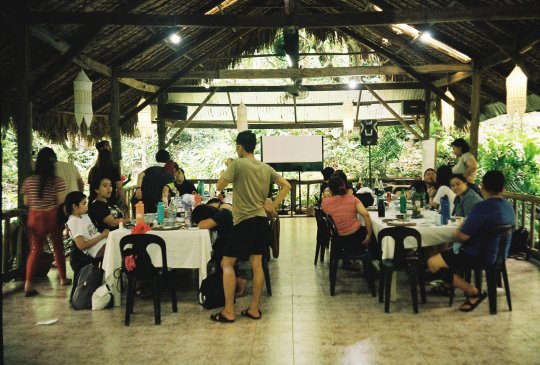


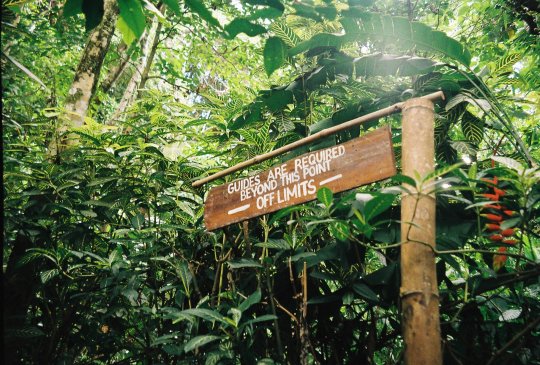


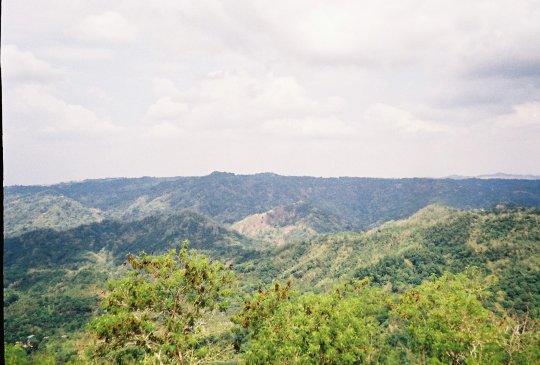
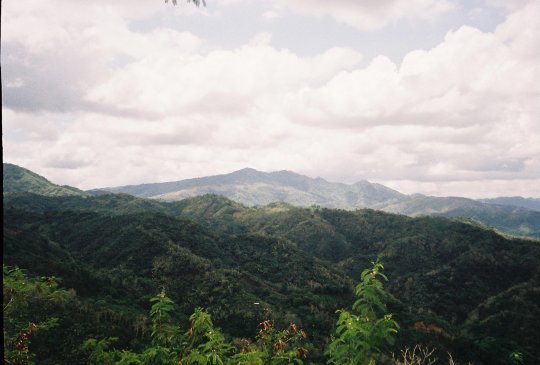

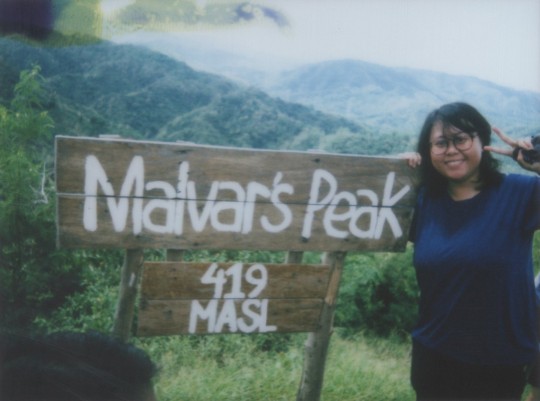
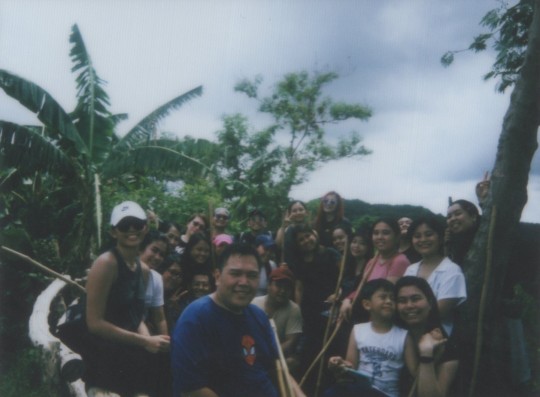


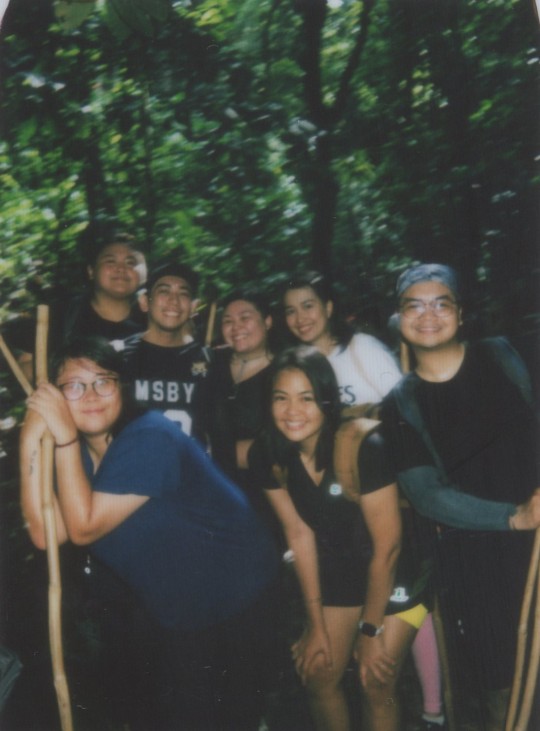
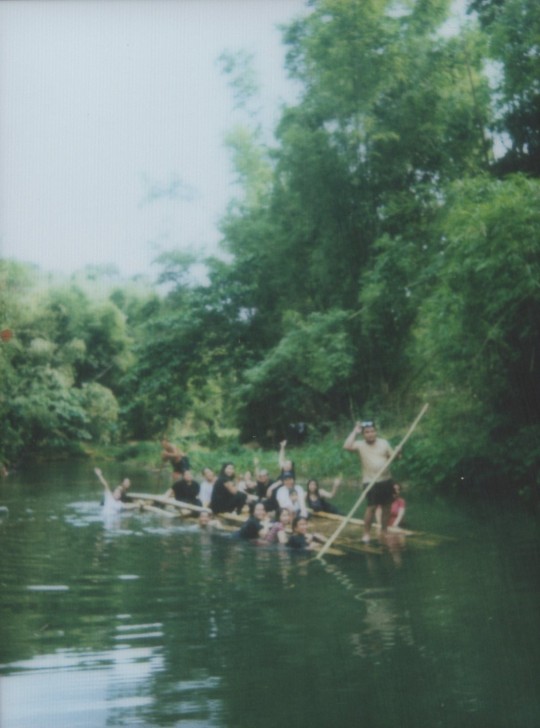
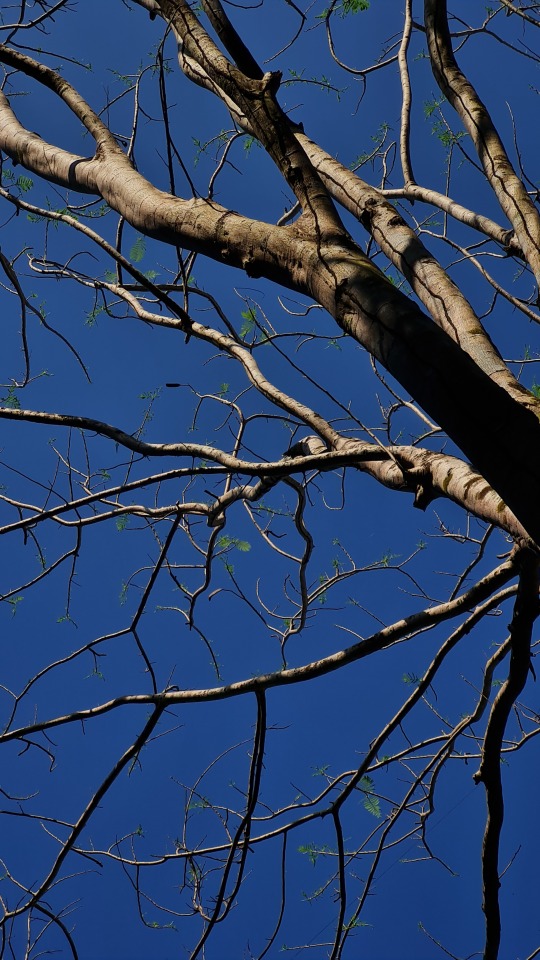
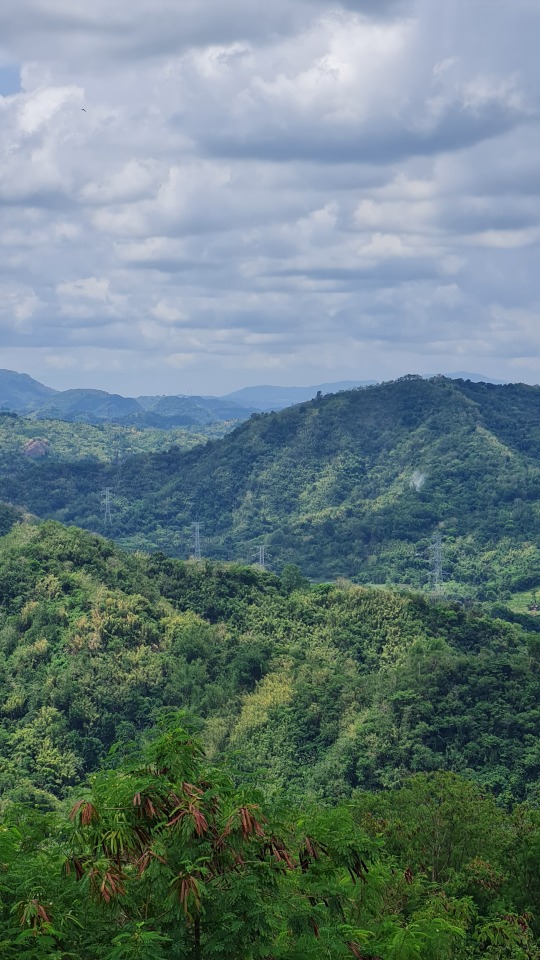



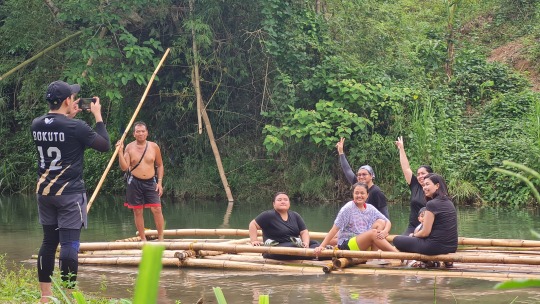



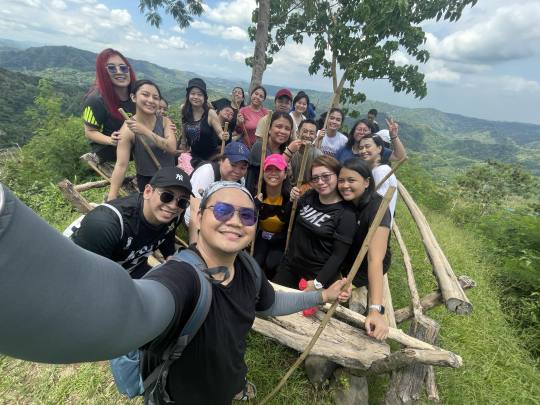
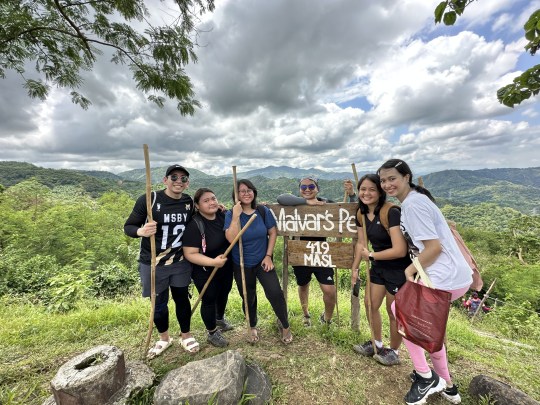

May 13, 2023
I’m back with another long-overdue post. This day hike trip happened five months ago, on May 13th. It was yet another planned trip arranged by my EG family. My last hike was at Mount Balagbag, and it was still with the same people. This time, they chose Mount Purro Nature Reserve, located in Antipolo, and more people from work joined.
Mount Purro Nature Reserve is a family-run eco-park tucked away in the foothills of the Sierra Madre Mountain Range, near Metro Manila. It is a simple yet distinct sustainable travel destination. It advocates a lifestyle of stewardship, simplicity, and sharing. Moreover, it highlights God, Nature, and People as the true measures of personal and community development. Along with its partner, MPNR Foundation, it pursues the dream of rehabilitating the Upper Marikina Watershed and empowering the communities living within, especially the indigenous Dumagat tribe.
I was really looking forward to this day. They said it was an easy hike, but as someone who is not in the best shape, I would rate this one 8/10 in terms of difficulty. I really struggled. The trail was all muddy, slippery, and steep, as it had been raining for days before. To make things even worse, my thighs were killing me because we had just started our hobby program, Rave Cycle. I could hardly bend my knees, and each step was pure pain. But they said to keep moving to loosen up the stiffness of the muscles, so I pushed myself.
Some of us found the difficulty level too challenging and decided not to continue to the peak (since most of us were first-time hikers), but I, not wanting to miss out on the opportunity, carried on. I was with the last group, the slower hikers, and we took it easy, going at our own pace to reach the top. After a short break on the peak for group photos, we hiked back down to the mini-conference area, our starting point. I was exhausted and starving, but just in time, lunch was served! Thankfully, the food included in our day trip package from Loli's Kitchen was delish!
After our meal and a brief rest, we proceeded to the second part of our day trip: the River Walk. The trek was quite long. To be honest, I felt a bit disappointed as we approached the river. I understand that people live in the area, but I had hoped they would maintain its cleanliness. There was litter everywhere, and the smell was far from pleasant. The mountain hike was beautiful, with no litter in sight, and I wished they'd taken the same care with the river.
Anyway, it was quite a day – another memorable memory with my EG tribe. Too bad we weren't able to meet the Dumagats due to COVID restrictions.
Grateful for the new memories we've made.
15 notes
·
View notes
Text










Charlie Lake, BC (No. 3)
Charlie Lake is located in the Peace region approximately 9km northwest of Fort St. John, B.C. The lake is roughly 15km long with maximum and mean depths of 15m and 6.4m, respectively. It has a surface area of 18km2 and a shoreline perimeter of 38km. Watershed land use activities include agriculture, range/grazing, oil and gas, forestry, recreation and residential development (page 2). The main inflowing tributary to Charlie Lake is Stoddart Creek, with other named tributaries including Coffee Creek and Fish Creek (Lower Stoddart Creek).
Charlie Lake contains the following sport fish: northern pike (Esox lucius), burbot (Lota lota), walleye (Stizostedion vitreum)
and yellow perch (Perca flavescens). There have been many successful stocking and colonization programs on Charlie Lake,
which date back to the early 1930s. There have also been some unsuccessful programs including both rainbow trout and large mouth bass.
The Charlie Lake shoreline is highly developed with two Provincial Parks, one Rotary Park, a golf course and approximately
1500-2000 residents. The main concern among many residents is the high loading of sediment and nutrients from both inflowing tributaries and shoreline practices. This nutrient addition to the lake, which has occurred during the past century, has lead
to an increased intensity of both green and blue-green algal blooms (French and Booth, 2004). The main source of these sediments and nutrients is thought to originate from poorly constructed/functioning road crossings, riparian land clearing, livestock
access to stream channels, poor water management at oil and gas wellhead sites and roads, domestic waste and foreshore residential development (French and Booth, 2004).
Source
#Charlie Lake Wetland#Charlie Lake#travel#original photography#vacation#tourist attraction#landmark#cityscape#architecture#landscape#lake shore#hills#woods#forest#British Columbia#small town#summer 2023#Canada#Maple Leaf Flag#Flag of Canada#windy#US flag#Alaska Highway Memorial by Shala Dobson and Jim Dault#Ross McLean Rotary Park#Creeping Thistle
2 notes
·
View notes
Text
Lake Erie phosphorus reduction
Protecting and preserving the state’s water quality continues to be a top priority for both the Michigan Department of Agriculture and Rural Development (MDARD) and the administration of Gov. Gretchen Whitmer and Lt. Gov. Garlin Gilchrist.One focal point of this mission is the Western Lake Erie Basin (WLEB), where sometimes-harmful algal blooms have affected aquatic life and drinking water in recent years. Factors contributing to algal blooms include nutrient-rich water from wastewater treatment plants and farm fields.While reductions of phosphorus at four of the key wastewater facilities in Michigan’s portion of the WLEB helped Michigan hit its 20% phosphorus loading reduction goal by 2020, they won’t be sufficient to achieve the 40% reduction target Michigan, Ohio, and Ontario agreed to reach by 2025 under the 2015 Western Basin of Lake Erie Collaborative Agreement.Moving forward, it will require new approaches to realize progress from agricultural contributions. MDARD is laser-focused on accelerating conservation in the right places across the WLEB watershed with programs and projects defining success through realistic and achievable water quality outcomes to restore the health of the Lake Erie ecosystem.While significant progress has been made with point sources (pollution from a single identifiable source or area), it’s time to put our foot on the gas pedal with agricultural nonpoint sources (pollution from many sources at once).In support of the governor’s MI Healthy Climate Plan, the Fiscal Year 2024 budget includes a total $15 million investment to support soil health, climatesmart agriculture practices, and regenerative agriculture. These priority areas aren’t solely about building stronger agricultural systems and resilient rural economies; they also place a specific focus on improved environmental outcomes.These investments in soil health to improve water quality are a notable shift in MDARD’s efforts to tackle nutrient losses. Managing agricultural systems to improve waterholding capacity and rainfall infiltration, while enhancing biological cycling to reduce the need for fertilizer inputs, is a paradigm shift in nutrient management for MDARD. Regenerative agriculture principles have been shown to not only reduce nutrient losses but mitigate the impacts of extreme weather – all while prioritizing the agricultural diversity that powers our rural communities.To better prioritize conservation practice implementation and quantify results, the Domestic Action Plan (DAP) Team, composed of staff from MDARD and the Michigan DNR and EGLE, is working with MSU to enhance the Great Lakes Watershed Management System to annually quantify phosphorus load reductions from conservation practice implementation relative to the 40% reduction goal. This public-facing online platform will include a dashboard that tracks water quality outcomes associated with social and ecological metrics, providing greater accountability for program implementation in Michigan’s portion of the WLEB.MDARD is dedicated to achieving demonstrable water quality improvements in Lake Erie. The state’s investments in soil health and regenerative agriculture principles hold the promise to not only improve water quality but enhance the climate resiliency of our agriculture systems, while placing value on how and where our food is grown.These new budget investments by Gov. Whitmer position Michigan to achieve long-term, tangible outcomes that take us beyond water quality.Take a deeper diveLearn more about phosphorus reduction efforts in Michigan’s portion of the Lake Erie watershed at Michigan.gov/LakeErieDAP.

#cleanwater#pollution prevention#protectourwaterways#environmentaleducation#protectourplanet#environmental education#michigan#egle#great lakes#greatlakes
2 notes
·
View notes
Text
Pedagogical puzzle of French watersheds
The first time we heard of NatExplorers was in February 2022, when Barbara Réthoré contacted us to see if they can use our river basin map of France to aid their next project. Loire Sentinelle in the summer of 2022 was a hybrid project, both scientific and artistic - so a perfect match to our map. Barbara and her partner Julien Chapuis walked and canoed along the Loire river in 80 days, covering 1000 km altogether, and carried out the very first joint assessment of plastic contamination (via microplastics sampling) and global biodiversity (via environmental DNA sampling) across the entire Loire continuum. During their stopovers they met the locals, organized creative programs for the public and, with the help of local artists, raised awareness about nature conservation in the Loire watershed.

There are many volunteers helping NatExplorers in the important work they are doing. One of them is Estelle, who developed pedagogical tools to help educate the public about the overall health of the Loire river and its biodiversity. Our colourful map of France seemed to provide a perfect base for a puzzle that people of all ages could enjoy.

The puzzle seemed to be so successful that they felt the need to improve it and recreate it from a sturdier material. With the help of a professional modeller, and after several weeks of learning and experimenting, Estelle managed to finish the puzzle. The finishing touch was to hand-paint all the pieces: a long and thorough work but as you can see, every minute was worth it. The final piece is 34x36 cm and made out of local cherry wood. It's the best thing that ever happened to our map of France, for sure.
The new puzzle will be used during some events in the summer and in Barbara and Julien's new expedition later in the year. We are very much looking forward to see the puzzle in action, and we wish all the best for NatExplorers in their journey.

All images © Natexplorers, used with permission.
#Natexplorers#NGO#environmentalism#environmental activism#loire#loire valley#French rivers#France#geography#river conservation#microplastics#river pollution#climate change#maps#maps reimagined#river map#puzzle#pedagogical tool#teaching geography
11 notes
·
View notes
Text

Future Air Combat System (FCAS) and the Military Internet of Things
Fernando Valduga By Fernando Valduga 11/22/2023 - 20:35in Military
The FCAS Air Combat Cloud (Air Combat Cloud) will bring real-time intelligence to the forefront, taking advantage of the network capabilities of different aircraft and platforms. Innovations in Artificial Intelligence (AI), big data processing and cybernetics will help make defense a truly collaborative mission.
Europe's Future Air Combat System (FCAS) will see next-generation manned jets flying alongside remotely piloted unmanned aircraft carriers of various sizes. These assets will be part of a fully interconnected "system of systems", based on open architectures, which will allow the integration of other existing platforms, such as the A400M or the A330 MRTT tanker plane. At the heart of this complex system will be the Air Combat Cloud, which will allow these platforms to work together.

But what exactly is an air combat cloud? As FCAS Combat Cloud product solution leader at Airbus, Ignacio Rosell often asks this question.

“How does the Android ecosystem work? We have an operating system that allows the integration of applications from different parts, and all this is supported by a communication infrastructure such as 5G, Bluetooth or Wi-Fi. If we apply this analogy to the FCAS, we are developing an important part of the "Internet of Military Things". Our mobile phones can be a fighter plane, an unmanned aerial system (UAS), a warship, a satellite or even a soldier on the ground, each integrating different applications or, in other words, different capabilities. Our air combat cloud has the same components, the communications infrastructure, the operating system and the applications that allow us to operate collaboratively," adds Rosell.
Launched by France, Germany and Spain, and with Airbus, Dassault Aviation and Indra as national industrial coordinators, the FCAS is one of the most important European defense programs of the coming decades. In a context of growing global instability, the objective of the project is nothing less than to design an air defense system that protects Europe, while strengthening its strategic autonomy and technological sovereignty.
Airbus leads the Combat Cloud pillar, with Thales and Indra as main partners. This is one of the seven areas of next-generation FCAS technology (see the infographic on the side), led at Airbus by Marc Paskowski.
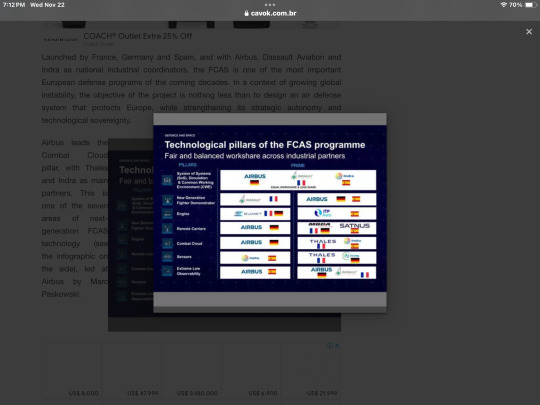
It will provide a common situational awareness, capturing, sharing, merging and instantly processing large amounts of data from all connected manned and unmanned platforms, reliably, and transforming that data into actionable information, taking advantage of constantly evolving learning technologies. "The concept based on the cloud in flight is that all elements must constantly interoperate with each other to form a cohesive system that is informed as one and fights as one," says Paskowski.
"Our 'operating system' will need to be opened to accommodate ready-to-use and tailored applications, such as manned and unmanned teams, from Airbus or any other industrial partner. It will be an evolutionary process, with new applications, such as new aerial platforms, being integrated along the way," says Rosell. "Our business model around the Combat Cloud will not be unique. An area such as satellite connectivity could be offered as a service, while an 'app' part of an aircraft's mission system could be sold as a product,” he adds.
The development of intermediate solutions as part of this "internet of military things" should allow customers to use various levels of cloud capabilities and remote operators long before FCAS became operational in the 2040s. For example, Airbus has already carried out the first successful launch and operation in the world of a Remote Carrier flight test demonstrator from an A400M in flight.

Based on this incremental approach, the air combat cloud will be the digital watershed in the way military operations are conducted.
“The ability to integrate, operate and communicate from a networked system will shape the air force of the future,” said German Air Force Lieutenant General Ingo Gerhartz
In fact, future scenarios will require a much higher degree of automation for information management and integration of military services and branches throughout the entire mission cycle. For FCAS, innovations in 'deep techs', such as big data processing, artificial intelligence and cybernetics, will provide the advanced intelligence of the cloud, allowing, for example, the distribution of Command and Control (C2) functions, including to the pilot in his fighter. and provide key stakeholders in a mission with all relevant information in real time. "This will give Air Force decision makers an unprecedented level of awareness," says Paskowski.
But with great power comes a great responsibility. With the growing dependence on artificial intelligence on everything we do as "digital citizens", and the use of platforms such as ChatGPT and its impact on the workplace, the integration of AI at the heart of FCAS Air Combat Cloud presents new challenges. Questions such as 'to what extent will the system support the decision-making process?' or 'What are the ethical criteria that can be applied to the use of this technology?'

Control or be controlled: that's the question
In order to anchor ethical issues and legal principles in the FCAS project, Airbus and the Fraunhofer Institute came together in 2019 to launch a joint expert committee on the responsible use of technologies. It brings together interested parties from the German Air Force with universities, research institutes and a broad group of foundations, specialists in social sciences and engineering science design.
Based on this guidance, within FCAS Air Combat Cloud, AI will provide analysis of complex situations during multi-domain operations and recommend the most intelligent action in the correct sequence. The human will then validate the recommendations. If the operational pace is high, the human being will simply decide whether or not to veto the recommendations, and the subsequent processes will again be automated by AI. “Our European air defense system will always be under the full control of a responsible human operator and in all circumstances,” concludes Marc Paskowski.
Both technologically and militarily, the development of FCAS has the potential to establish new standards and revolutionize the use of air power.

The use of AI in Airbus
Airbus began integrating AI into its products and solutions in the 1990s, with applications for reading and interpreting satellite images.
OneAtlas imaging services harness the power of Airbus' constellation of optical and radar satellites with reliable AI and cloud technology to provide important information, for example, to combat deforestation, optimize agricultural yields and urban planning.
However, in the aeronautical sector, Airbus' Skywise big data platform collects data from 24,000 aircraft parameters, allowing airlines that subscribe to the service to perform predictive maintenance and improve the overall operational efficiency of their fleets.
Tags: airbusMilitary AviationFCAS - Future Combat Air System/Future Air Combat System
Sharing
tweet
Fernando Valduga
Fernando Valduga
Aviation photographer and pilot since 1992, has participated in several events and air operations, such as Cruzex, AirVenture, Dayton Airshow and FIDAE. He has work published in specialized aviation magazines in Brazil and abroad. Uses Canon equipment during his photographic work in the world of aviation.
Related news
WAR ZONES
AC-130J aircraft attacks militants in Iraq after first ballistic missile attack against U.S. positions
22/11/2023 - 16:00
MILITARY
F-35 fighters will cost Canada almost $54 billion in 45 years
22/11/2023 - 14:19
MILITARY
Indonesian Air Force receives new Dassault Falcon 8X aircraft
22/11/2023 - 14:03
MILITARY
Russian Air Force receives new batch of Su-34 fighter-bombers
22/11/2023 - 10:46
MILITARY
VIDEO: The impressive attack of the Houthis, with a Mi-171, on a cargo ship in the Red Sea
21/11/2023 - 23:09
BRAZIL
VIDEO: FAB celebrates 40 years of the T-27 Tucano aircraft with special paint
21/11/2023 - 19:30
Client PortalClient PortalClient PortalClient PortalClient PortalClient PortalClient PortalClient PortalhomeMain PageEditorialsINFORMATIONeventsCooperateSpecialitiesadvertiseabout
Cavok Brazil - Digital Tchê Web Creation
Commercial
Executive
Helicopters
HISTORY
Military
Brazilian Air Force
Space
Specialities
Cavok Brazil - Digital Tchê Web Creation
4 notes
·
View notes
Text
LGBTQ+ questions begin the test phase for the Census Bureau’s annual community survey
The U.S. Census Bureau has begun testing its sexual orientation and gender identity questions in preparation for its American Community Survey (ACS). The White House’s Office of Management and Budget (OMB) approved the August survey, and the results will be published in early 2026.
President Joe Biden issued a directive for federal agencies to improve their collection methods of LGBTQ+ demographic data, and OMB officials signed off on the new questions on July 11.
Related
Exploring Kamala Harris’ progressive stances: Equity, justice, and change
Kamala Harris has a vision for a fairer future! From taxing the wealthy to advocating for LGBTQ+ rights, learn how she’s championing change.
“As planned, the 2024 American Community Survey SOGI [sexual orientation and gender identity data]. Test is underway. The test began earlier this month [August] and will continue through late 2024. The Census Bureau will publish the results of the test roughly 18 months later,” a spokesperson for the federal agency told the Bay Area Reporter last week.
Stay connected to your community
Connect with the issues and events that impact your community at home and beyond by subscribing to our newsletter.
Subscribe to our Newsletter today
The ACS is a federal questionnaire sent monthly to 295,000 households in the U.S., including Puerto Rico. It allows the government to collect housing and socioeconomic data, which the Census Bureau says allows them to “provide timely and relevant housing and socioeconomic statistics, even for low levels of geography.”
Nancy Bates, a lesbian and former Census Bureau official, said that the testing of SOGI questions is a major development that will allow the organization to better understand the lives of LGBTQ+ people in the United States and how to better them.
“I am heartened to hear that testing of both gender identity and sexual orientation are underway in the American Community Survey. This is a watershed moment for both the Census Bureau and the entire US federal statistical system. I eagerly await the findings and ultimate implications this will have for the LGBTQI+ community,” Bates told the Bay Area Reporter.
The ACS currently collects data on same-sex households, much like the decennial census forms. However, it has yet to gather individual SOGI data for every person residing at the 3.5 million addresses that receive the survey annually. The decision to permanently include LGBTQ+ demographic questions in the survey remains years away and will depend on the outcomes of the testing phase.
Meeta Anand, senior director of the conference’s census and data equity program, and Whitman-Walker Institute director of policy Caroline Medina both say that adding the questions is crucial.
“Ensuring inclusive and responsible SOGI data collection on the ACS would provide a more comprehensive picture of the needs and experiences of LGBTQI+ communities so they can be better reflected in policies, programs, funding investments, and enforcement of civil rights laws — including those to protect LGBTQI+ people from discrimination and ensure equal opportunity,” their blog post reads. http://dlvr.it/TCt5LC
0 notes
Text
The ninth International Degrowth Conference, held in August this year in Zagreb, Croatia, opens with a provocation. Keynote speaker Diana Ürge-Vorsatz, the newly elected vice chair of the Intergovernmental Panel on Climate Change (IPCC), has two requests to make of the audience. The first is to figure out how to coordinate with governments of all stripes, since the climate crisis requires global unity.
The second? “Maybe consider a different word.”
It’s about as close to blasphemy as this niche, academic, and politically radical conference can get.
To a rising minority of European leftists, the term “degrowth” is proving an attraction rather than a turnoff. The protean climate movement that exists under its banner is gaining momentum among academics, youth activists, and, increasingly, policymakers across the continent.
The European Parliament hosted its second (and terminologically defanged) Beyond Growth Conference just this past May, this time with unprecedented buy-in from elected officials; as organizer and European Parliament member Philippe Lamberts (of the Belgian Greens) told the Financial Times, the “big shots” are now “playing ball.”
Those in Zagreb frame the Brussels push as “extraordinary” and “major,” with the parliament building “filled to the brim” by a new swell of activists, nongovernmental organizations, academics, and elected officials totaling some 7,000 strong. Julia Steinberger, a longtime researcher of the social and economic impacts of climate change at the University of Lausanne, adds: “And they were young.”
This energy carries over to the degrowth circuit proper, which multiple veterans tell me has long outgrown its humble beginnings. At a watershed, self-organized gathering in Leipzig, Germany in 2014, ragtag participants made their own meals. This year’s conference, by contrast, is co-sponsored by the city of Zagreb, attended by the mayor and representatives of the IPCC, and professionally catered with vegan canapés.
With its deepest roots in direct democracy and anti-capitalism, the degrowth movement is bent on challenging the central tenet of postwar economics: that further increases in GDP—strongly correlated with increases in carbon emissions—translate to further advances in social and individual well-being.
The implications of the critique extend far beyond the usual calls for countries to reach net-zero emissions targets. To degrowthers, the climate crisis is a social problem, and addressing it will require no less than reengineering the entire global, socioeconomic order, especially in the wealthy global north.
Why the sudden interest in this radical program? Why Europe, and why now?
Perhaps the answer should be obvious: Late August 2023, when the Zagreb event convenes, caps off the hottest global summer ever recorded. The defining characteristic of degrowth’s latest influx of followers, as the movement’s major figures will stress to me again and again over the next four days, is youth—which is to say, a heightened vulnerability to the future effects of climate change.
The status quo has left these young supporters disillusioned and alarmed. And no wonder. When, during her keynote address, Ürge-Vorsatz draws up a heat map showing the proportion of the Earth that will become unsuitable for human life by 2070 under business-as-usual projections, no one bats an eye; it’s data that this particular audience has seen before.
The suggestion to “find a better word,” however, is met with an affronted laugh. For Europe’s young people, degrowth isn’t just a utopian slogan, but an intentionally provocative, environmental necessity—and an existing reality.
Parallel to these radical calls to abandon economic growth as a policy goal, many economists have observed that capitalism in developed countries is already slowing down, seemingly of its own accord, and very much against the mainstream political will. The trend is called (in a manner that hardly satisfies Ürge-Vorsatz’s invitation to find a more appealing term) “secular stagnation,” and it predicts that in highly developed economies, a near future of stagnant growth is more or less inevitable.
This slowdown in the year-over-year growth of GDP per capita is detectible in wealthy industrialized countries such as Japan, Germany, France, the United Kingdom, and the United States, according to economists such as Dietrich Vollrath, whose book Fully Grown describes this phenomenon.
The deceleration is accompanied by a rise in inequality, which contributes to increased polarization on both the left and the right. Poorly managed energy transitions and climate-induced disasters are poised to exacerbate the trend. So are declining fertility rates, which lead to a lopsided age distribution in the workforce, putting further strain on welfare systems. While it is tempting to ascribe the decline in birth rates primarily to the rising cost of having children in rich countries, in the EU, generous benefits to parents (Hungary, for example, recently waived personal income tax for mothers under 30, among other pro-family measures) have failed to turn the tide. At a certain point, wealthy societies in advanced stages of modern capitalism no longer want to grow.
As a consequence, for the first time since the mid-20th-century, young people from the world’s richest nations, such as those gathered here in Zagreb, cannot expect to be better off than their parents.
The anxious backdrop is enough to make one wonder whether the uptick of interest in degrowth isn’t, in fact, just another symptom of a lack of economic growth in Europe, coupled with impending environmental degradation. It brings into focus a bigger historical picture, one of wealthy countries around the world struggling to manage ecological decline and rising domestic discontent when the usual remedy—rapid growth—may be as economically impossible as it is environmentally dubious.
If such degrowth is inevitable, degrowthers ask—if for a very different set of reasons—how can it best be managed?
And is it possible for Europe to greet it with anything other than anxiety and despair?
On the opening night of the International Degrowth Conference, at a reception held in the lobby of the Zagreb Museum of Contemporary Art, at least two surveys of the 680 registered participants are going around, gathering demographics in the name of ongoing academic research. The shoe-leather approach provides a good estimate: A quick turn though the crowd proves the attendees to be overwhelmingly white, youthful, and fit.
And yet, considerable diversity exists within that apparent uniformity. Degrowth is a big tent, one that attracts graduate students, activists, Marxists, feminists, decolonizationists, and in more recent years, elected politicians, all of them disillusioned with the promises of “green growth” inscribed in the EU Green Deal, or in the United States’ growth-oriented Inflation Reduction Act. It could be described as an academic field, an intellectual crossroads, a political movement—or better yet, given its versatile nature, as a cultural one.
The term decroissance first emerged in France during the resource debates of the 1970s, when the Club of Rome published its famous 1972 report, The Limits to Growth, which is still one of the most controversial and bestselling environmental books of all time. That study argued that exploding global population and resource use would exceed the Earth’s carrying capacity within one generation, resulting in a precipitous decline in welfare.
Strongly influenced by a natural scientist’s understanding of the conservation of energy (as opposed to an economist’s understanding of abstract and theoretically limitless variables, such as demand), the report popularized the enduring idea that there is no infinite growth on a finite planet. Kenneth Boulding, author of the essay “The Economics of the Coming Spaceship Earth,” echoed the concept in congressional testimony delivered during a discussion of the global ecological situation in 1973: “Anyone who believes that exponential growth can go on forever in a finite world is either a madman or an economist.”
Predicting the future is a risky business. The Club of Rome report was—and still is—ridiculed by mainstream analysts, who pointed to the fact that the next generation became, au contraire, ever richer and more populous. Others rightly questioned the report’s tendency to stoke the West’s racist fears of population growth in the global south. From a purely ecological view, however, research from natural scientists continues to suggest that the 1972 study got more right than wrong; ecologists warn that we have now exceeded four of nine planetary boundaries that define a habitable planet.
Today’s iteration of degrowth, translated from the French, disavows these earlier debates’ Malthusian focus on population growth, instead shifting the emphasis to per capita consumption. This time, the culprit is decadence in the global north.
Embracing the ethos of anti-consumerism, anti-advertising, and decolonization, the idea of reorienting rich economies away from the hegemonic pursuit of GDP growth gained purchase in France and Southern Europe following the 2008-09 financial crisis—which was seen as yet another consequence of the reckless pursuit of growth—and the austerity measures that it drew into its wake.
Vincent Liegey, a French thinker, author, and organizer who was active in those earliest years of the degrowth movement, tells me that these days, degrowth might be best understood as a “tool,” one used “to question dominant paradigms and address 21st-century problems with [the idea of] well-being.”
There’s an academic flair to the accrual of terms and definitions in the conversations that I have over the next four days: “conviviality,” “frugal abundance,” and “well-being” are favored. (A primer from one of the movement’s foremost thinkers, George Kallis, bears the title Degrowth: Vocabulary for a New Era.) Marxism is more than ambient. But so are appeals for direct democracy and municipalism, as well as serious engagement from NGOs and members of the European Parliament.
It can be difficult to keep track of where the ideological accent lies. In their book The Future Is Degrowth, Matthias Schmelzer, Aaron Vansintjan, and Andrea Vetter helpfully break the movement down into different “currents,” of which there are two dominant schools: green-liberal economic reform, which relies on familiar tools (such as market mechanisms, taxation and regulation) to bring growth and institutions into accord with planetary boundaries; and “socialism without growth,” which focuses more on fundamental changes to distribution and ownership (and which distinguishes itself from the Marxist productivism practiced in Soviet Russia or Maoist China).
Natural scientists, too, supply working definitions. One of the most common (and politically neutral-sounding) goals repeated in Zagreb harkens back to a widely circulated 2020 Nature Communications paper titled “Scientists’ Warning on Affluence”: Drawing on economist Giorgos Kallis’s definition, the paper’s authors argue that degrowth aims for an “equitable downscaling of throughput (that is the energy and resource flows through an economy, strongly coupled to GDP), with a concomitant securing of well-being.”
“There’s always been an activist and an academic part of the movement,” the aforementioned Steinberger, a co-author of that paper, tells me. Though both factions have historically lacked traction with the broader public, 2023 may be the year this marginal status starts to change. Degrowth has made “giant steps forward” in “how we can articulate these ideas and how we can make them popular,” Steinberger says, pointing to the May conference in Brussels as an example.
Ürge-Vorsatz likewise welcomes the new momentum as a “really exciting development,” one further linked to recent degrowth-adjacent legislation such as a draft directive proposed in the European Parliament that would ban “planned obsolescence” and increase the durability of consumer goods.
There are further signs of momentum. The sixth IPCC assessment report, published last year, made its first mention of degrowth, citing the literature’s “key insight” that “pursuing climate goals … requires holistic thinking including on how to measure well-being,” and name-checking the movement’s “serious consideration of the notion of ecological limits.”
The writing of Japanese philosopher Kohei Saito, a rising international star (and also in attendance in Zagreb), has become a surprise hit in Japan and around the globe, with his 2020 book Capital in the Anthropocene grossing more than 500,000 copies; the week of the conference, he was profiled in the New York Times for his philosophy of “degrowth communism,” while a German translation had just appeared on the Der Spiegel bestseller list.
And it’s a kind of “cultural victory,” Liegey says, that policy magazines such as the Economist and the Financial Times, not to mention the present publication, have also begun to engage—even if only to debunk degrowth as a brewing economic disaster.
Pressed to explain the surge in interest, however, it’s notable that many organizers and researchers didn’t cite concrete proposals from degrowth’s own economic agenda, but rather the ruins of the old, postwar paradigm.
They cited record-breaking temperatures that have risen quite literally off the charts. They cited the pandemic, an experiment in rapid social transformation that has broadened the public imagination for what is possible in a narrow time frame. They cited, above all, the energy of the younger generation of activists heralding from Ende Gelände, Extinction Rebellion, Fridays for Future, and the many youth and graduate students who are getting involved in degrowth itself.
One such newcomer, here in Zagreb as a volunteer, tells me that she discovered degrowth after becoming disillusioned with green growth narratives and party politics in her native France. “I’m not sure how much is propaganda,” she says with a laugh, gesturing toward the cacophony of workshops and academic presentations taking place simultaneously in the conference center (the usual purpose of which, I’m told, is to host weddings; at least three can take place here at once). But she admits that she finds it “inspiring to see so many people working on solutions” after more mainstream channels left her pessimistic.
She is not the only person attracted to Europe’s degrowth movement by a combination of pessimism about the current conditions of the world and the promise of political solutions to quell that anxiety. But degrowth also raises the question of just how real these solutions are meant to be—or whether managing pessimism is the primary draw.
Asked to explain why the movement continues to enjoy more support in Europe as compared to other parts of the industrialized world, degrowthers point to the continent’s long tradition of leftist organizing and greater cultural openness to restraining the excesses of capitalism.
“There’s more freedom in Europe to question mainstream economics and the growth paradigm,” says Steinberger, who received her Ph.D. in physics from the Massachusetts Institute of Technology. “It’s not that it’s comfortable,” she adds, “but it’s at least … nobody’s going to [be] fired for it. It doesn’t generate the same sort of kneejerk revulsion.”
Saito, who studied in both the United States and Europe before returning to his native Tokyo, where he is now a professor of philosophy at Tokyo University, echoes the claim: “I think in some sense, EU countries already regulate this system of capitalism, creating other space for other things, for noncommercial activities. And that’s already half-degrowth.”
But there is, potentially, a broader cultural backdrop to the increased interest, especially among the young. Gwendoline Delbos-Corfield, a member of the European Parliament representing France (and the Group of the Greens/European Free Alliance parties), tells me that the youth she speaks with are notably pessimistic. “Girls tell me we shouldn’t be having children because it harms the planet,” she says.
Youthful (and hyperbolic) critiques of the status quo are hardly novel to European politics. But the current attitude feels distinct from the student protests that swept the continent in the 1960s: “I feel there is more despair,” Delbos-Corfield adds.
There’s always been an anti-materialist, anti-capitalist bent among green revolutionaries in the West, but degrowth should also be understood as separate from the back-to-the-land or hippie spiritualism that marked the environmentalism of the 1970s. The main drivers on display in Zagreb are economic and environmental anxiety as the world slips into very real ecological and civic unrest.
“They have a lot of access to depressive information,” Liegey says of the young people he sees joining and reshaping the movement, “and no way of acting on it.” Ürge-Vorsatz echoes his assessment. “If you just look at climate [policy] in Europe,” she says, “then I think we should be very positive because Europe has been doing great things.” On that front, there’s reason for optimism. But as for the broader political landscape, she notes that it often seems as if Europe is entering “into an era of crisis after crisis after crisis” that will require an updated political vision: “The only way we can actually manage crisis is to think for the long term.”
Charges of pessimism, alongside demands for continued economic development in the global south, are arguably where critics gain the most traction against degrowth. Self-described “techno-optimist” thinkers such as Andrew McAfee and Steven Pinker have more or less self-consciously pitted themselves against it. Regarding climate goals, these thinkers call for more growth, not less, and especially for the so-called decoupling of that growth from increased material resource use. Their self-described optimism stems from the fact that this decoupling is already taking place; they reckon it can be accelerated through new technologies and judicious policy.
It’s worth noting that across this very fraught and contested spectrum of opinions—from techno-optimism and green growth to degrowth—everyone agrees on one thing: In order to avoid the very worst of possible climate futures, the material and carbon throughput of the economy must be drastically reduced. The attitude in which they go about achieving that reduction, however, could not be more different.
There is indeed evidence that relative decoupling has been underway since the mid-20th century, but so far only partially, and only in rich countries—and then only after an enormous intensification of resource use. Early evidence of dematerialization from midcentury peaks in countries such as the United States, furthermore, does not yet extend to powerhouses such as India or China.
It is also hotly debated whether this partial trend properly accounts for rich countries’ offshoring of material-intensive manufacturing, or for the so-called rebound effect, whereby more efficient and “dematerialized” production of goods and services translates directly into increased consumption, immediately canceling out ecological gains. Degrowthers, for their part, argue that the absolute decoupling is an outright fairy tale—one as dangerous as its proponents accuse degrowth of being.
Whether decoupling amounts to magical thinking or not, given current data, one would have to be very optimistic indeed to believe that decoupling scenarios alone will bring economic activity into accord with planetary boundaries and tipping points. The lack of evidence for an immediate silver bullet brings us back to the multitrillion-dollar question: If an economic deceleration is inevitable, are our options really delusion versus despair?
It’s no mystery why we fear economic slowdowns. Crumbling state finances, recessions, and economic transitions are enormously painful and disruptive, especially for those in the lowest income brackets. Juicing growth numbers as a means of alleviating economic pain and discontent, however, is increasingly looking like a holdover from an era when politicians could promise that rapidly rising tides lift all boats.
In today’s world—when global inequality is reaching prewar levels—it perhaps makes sense to lay at least equal focus on the redistribution of wealth accumulated in the 20th century, precisely with an eye toward insulating society’s most vulnerable from economic and environmental shocks that are increasingly intertwined. This makes even more sense if we consider that in the rich world, the previous century’s boom-time growth rates might be the result of nonlinear, irreproducible events, such as women entering the workforce, globalization, the financialization of government debt, and the use of imperialist force.
Perhaps, as techno-optimists predict, artificial intelligence will lead to yet another gain in productivity, yielding a 20th-century-style spike in growth. (Though this comes with the potential cost of AI turning on its human makers, which would hardly be conducive to economic flourishing.) For now, the shifting composition of developed economies calls for a correspondingly historic shift in policy focus.
“A fundamental difference between natural science theories and social science theories is that natural science theories, if valid, hold for all times and places,” former U.S. Treasury Secretary Larry Summers wrote in a opinion for the International Monetary Fund published in 2020, “In contrast, the relevance of economic theories depends on context.” He continued: “I am increasingly convinced that current macroeconomic theories … may be unsuited to current economic reality and so provide misguided policy prescriptions.” The same could be true of chasing after GDP growth.
In that case, one might imagine that it would be the task of the degrowth movement to persuade the broader public of the point. And yet, if the idea of doing more with less has a branding problem—which is to say, a political problem—it’s not a problem that anyone in the degrowth movement seems immediately positioned to solve. Almost no one I speak to in Zagreb is inclined to “consider a better word.”
The issue of language and popular appeal hovers over the conference. On a smoke break, a local Croatian volunteer, a mother of two with a marketing background, voices concern over how the scholars gathered here plan on communicating degrowth to a larger audience. She tells me that her school-aged children recently came home announcing they no longer want to shop at secondhand stores. “It feels very different to degrow when it’s a necessity versus a choice,” she says.
During lunch, over plates of (vegan) lentil Bolognese, another volunteer, a Zagreb native in her 20s and a member of a local all-female eco-collective, shares impressions from her own visits to the academic sessions, many of which are open to the public. She’s come directly from a presentation about a hypothetical “ecofeminist city,” where she, too, wondered about vocabulary and broader appeal. “The girls in my eco-village, the ones [the presenters] should be speaking for,” she says, “I don’t think they would have the education to understand. I wondered, ‘Who is your audience?’”
Consulting the abstract for the ecofeminist city in question, the authors’ proposals indeed seem less than tangible or concrete: References include “configuration of spatial and temporary infrastructures” and “feminist time politics.”
The volunteer’s question—“Who is your audience?”—is a fair one, especially since parts of the movement really do hold the potential for popular interest.
After all, the primary aim of degrowth, Saito explains, is to carve a space “outside of capitalism,” whose market logic has colonized too much of our social and economic decision-making, but also outside of traditional socialism or Marxist productivism, whose ecological record in Maoist China and Soviet Russia proved just as devastating.
Though I’ve been wondering whether it’s the word “communism” or “degrowth” that poses the greater threat to the movement going mainstream, the more I ask, the more it seems that to degrowthers such as Saito, “communism” means something much closer to municipalism and an expansion of the welfare state (financed, presumably, through a mechanism that rejects both imperialism and economic growth) than it does to classical economic planning.
“I call it commonification,” Saito says of his own updating of Marxist principles for a climate-distressed era. “Make it common; make it common wealth. A society based on that kind of commonification of our basic needs, which shouldn’t be left to the market logic.” Every thinker I speak with is committed to democracy and rejects the one-party state. Saito easily sees room for market mechanisms: “Of course you should be able to buy an apple or an orange on the market. But does that apple need to come from Africa?” There is a commitment to an expansion of social services such as universal health care, education, public transport, and housing, with additional discussion of reduced work weeks and job guarantees; people use less energy and fewer resources when they buy and work less.
Saito himself doesn’t mind if others “use a different term” than degrowth “as long as they’re willing to think outside of capitalism.” But he notes that using provocative language often serves an important purpose; degrowth was coined precisely to be unmarketable, with its founders anticipating the greenwashing that has befallen the likes of terms such as “sustainability,” “green growth,” and “carbon footprint.”
The persistent use of radical terms, Saito further argues, can pave the way for progress. “Ten years ago,” he says, “in America, you couldn’t say the word ‘socialism.’ Today the taboo has been lifted, with politicians like Bernie Sanders and AOC [Alexandria Ocasio-Cortez].”
On the other hand, one could just as easily argue that the normalization of former taboos is simply a sign of greater polarization and discontentment with capitalism; taboos are being lifted just as quickly on right.
In this tense political environment, should the degrowth movement continue in its usual role of leftist activists and academics, or has the time come to think more like politicians—in other words, people who have to compromise?
On this point, the movement seems divided.
It’s clear, however, which faction is ascendent. On a concluding panel, activist and scholar Julia Steinberger, who wields considerable influence on social media, recaps the need to liaise between the public and centers of political power. “Science tells us we need to degrow,” she says, “but this means nothing to politicians unless we can also help them translate this to the public.”
She describes presenting data to elected officials, only to have them respond that their hands are tied unless they are also given a way to sell the implications: “And we said, ‘We thought that was your job and the journalists’ job.’ And they said, ‘No, we can’t do it, and the journalists aren’t doing it, so I guess it’s your job.’”
Natural allies for the movement, not to mention connections to more mainstream economics, do exist. If degrowth plays its cards right, its proponents might not have to do the job alone.
9 notes
·
View notes
Text
Lewis Hamilton: A Trailblazer in Formula 1
Lewis Hamilton is more than just a Formula 1 driver — he’s a living legend. As one of the most successful drivers in the history of the sport, Hamilton’s impact goes beyond the race track. He has shattered records, pushed the boundaries of what’s possible in motorsport, and used his platform to advocate for change, diversity, and environmental awareness. His journey from a young boy racing go-karts in England to becoming a seven-time Formula 1 World Champion is nothing short of extraordinary.
Early Life and Racing Beginnings
Lewis Carl Davidson Hamilton was born on January 7, 1985, in Stevenage, Hertfordshire, England. His passion for racing started at a young age when his father, Anthony Hamilton, gifted him a remote-controlled car. Lewis quickly showed an innate talent for racing, and at the age of eight, he began karting — a sport that would set him on the path to Formula 1 greatness.
Hamilton’s talent was undeniable, and he quickly rose through the ranks of British karting, winning numerous championships. His big break came when he was signed to McLaren’s driver development program at the age of 13 — a move that would eventually lead him to Formula 1 stardom.
Formula 1 Debut: A Star is Born
In 2007, Hamilton made his Formula 1 debut with McLaren, becoming the first Black driver to race in the sport. His rookie season was nothing short of spectacular, as he finished third in his first race and went on to win four Grands Prix. He narrowly missed out on the championship, finishing just one point behind Ferrari’s Kimi Räikkönen, but his debut season cemented him as a future star.
The following year, in 2008, Hamilton made history by becoming the youngest-ever Formula 1 World Champion at the time, securing the title in dramatic fashion at the final race of the season in Brazil. His victory was a watershed moment in the sport, marking the arrival of a new era of racing.
Dominance with Mercedes: The Record Breaker
After six seasons with McLaren, Hamilton made a career-defining move to Mercedes in 2013. It was with Mercedes that Hamilton’s career reached unprecedented heights. Between 2014 and 2020, Hamilton won six more World Championships, tying Michael Schumacher’s record of seven titles — the most in the history of the sport.
During this period, Hamilton not only dominated the sport but also broke countless records, including the most pole positions, most Grand Prix wins, and most podium finishes. His consistency, speed, and determination allowed him to become the face of Formula 1 and one of the greatest athletes in the world.
Advocacy and Legacy
Beyond his on-track achievements, Hamilton has become a leading advocate for diversity and inclusion in motorsport. As the only Black driver in Formula 1, he has often spoken out about the lack of diversity in the sport and has been a vocal supporter of the Black Lives Matter movement. In 2020, he launched the Hamilton Commission, a research initiative aimed at improving diversity in British motorsport.
Hamilton’s advocacy extends beyond social issues. He is also a passionate environmentalist and has made significant changes in his lifestyle to reduce his carbon footprint. He’s pushed Formula 1 to adopt greener technologies and has used his platform to promote sustainability and raise awareness about climate change.
Off the Track: Music, Fashion, and More
Lewis Hamilton’s interests are not confined to racing. He has ventured into fashion, frequently collaborating with high-profile brands like Tommy Hilfiger, and has become known for his bold and distinctive style. In addition to fashion, Hamilton has a deep love for music and has even recorded songs under the pseudonym “XNDA,” though he’s kept his musical pursuits largely private.
Hamilton’s diverse interests highlight his multifaceted personality. He’s not just a driver but a global icon who influences culture, sport, and activism in a way few athletes ever have.
A Living Legend
Lewis Hamilton’s career is a testament to his extraordinary talent, resilience, and dedication. From breaking records on the track to breaking barriers off it, Hamilton has redefined what it means to be a Formula 1 driver. As he continues his journey in the sport, Hamilton’s legacy as one of the greatest drivers of all time is secure, and his impact on motorsport, diversity, and the world at large will be felt for generations to come.
0 notes
Text
Participatory Watershed Management for Rural Livelihoods in Gibe, Ethiopia

Abstract
The sustainability of environmental management practices such as watershed management intervention strategies relies on the understanding of the connection of the rural community’s participation, and livelihoods. However, there have not been many efforts effort to document the relationship between watershed management and sustainable livelihoods. In line with this, the research has assessed the role of participatory watershed management practices for sustainable rural livelihood improvement in Handosha Watershed, Gibe district, Southern Ethiopia. To address the above objective, household survey, focus group discussion and key informant interview were employed to collect and analyze the data from 122 randomly selected households in four sub-watersheds. Descriptive analysis, independent t-test and chi-square test were applied to analyze the data. The result of the study indicated that the collective value of overall livelihood assets and the specific major components that encompass crop diversification, food availability, land productivity, and physical assets were better after watershed intervention than before watershed intervention. The key finding of the research presents that due to different interventions the livelihood of the community was diversified and enhanced especially; profits, soil fertility, crop productivity, forest, water and food availability become enhanced. Findings of the study suggested that further emphasis is needed to enhance the households’ livelihood assets for sustainability of livelihoods. Local administrators and development agents need to recognize socio economic and topographic specific features as well as the constraints to involve society fully in various activities of participatory watershed management activities.

Introduction
Sustainable livelihood improvement is a growing issue, particularly in the developing countries given the mounting challenge of poverty, low economic development and poor agricultural. Ethiopia is not an exception where the degradation of land resource base and associated decreasing land productivity have been a major challenge for the sustenance of livelihoods of people (Teklewold et al., 2013). Agriculture is the economic mainstay of the overwhelming majority of people in Ethiopia and will continue to be the base for sustainable livelihood of the country (Gessesse et al., 2016). However, the ongoing watershed degradation in the form of soil erosion and soil nutrient depletion is the threatening factor for agricultural development (Shiferaw and Singh 2010). The degradation of watershed has been associated with the interacting effects of biophysical and socioeconomic factors and exacerbated by rapid population growth which would be resulted in not only decreasing land productivity but also aggravate ecological degradation, hampered households’ livelihood improvement and social development (Kerse 2018). In addition, much watershed conservation related research in Ethiopia is fragmented, focusing on biophysical (Taye et al., 2015) and economic returns (Kassie et al., 2011). Furthermore, a more specific conceptual framework that explains the nexus of the perception, community participation, and livelihoods to- wards sustained watershed management program is rarely found.
In response to the watershed degradation problems in the country, massive conservation, rehabilitation and afforestation movements were undertaken in Ethiopia (Engdawork & Bork, 2014; Tesfahunegn et al., 2012). Furthermore, conservation measures had been regularly accepted by farmers aimed decreased soil erosion, increased soil fertility and safeguarding the soil long-term productivity (Moges & Amsalu, 2017) and achievements in food security, poverty reduction and ecological sustainability (de Graaff et al., 2008; [Teshome et al., 2016). The acceptance of watershed management practices has been considered as agricultural development policy. Farmers gain incentives from agricultural and international initiatives to invest watershed management practices (de Graaff et al., 2013). However, the efforts couldn’t bring perceived changes as expected (Teshome et al., 2016). Consequently, this brought a low acceptance rate of some of these sustainable watershed management practices in the rural regions( Berresaw et al., 2010) for its top-down approach (de Graaff et al., 2013). As farmers were completely ignored from decision making in the selection, designing evaluation and implementation processes of watershed management practices The conservation measures in place were also undertaken without farmer’s interest and conviction. As a result, these drive the farmers to remove conservation structures following the change of foodfor- work programs (Deressa et al., 2009). Furthermore, there was little monitoring and assessment of the status of conservation measures and moreover, negligible maintenance for their sustainability (de Graaff et al., 2013). On the other hand, failure conservation efforts emanated from the fact that was implementing agencies couldn’t notice local level institutional, physical and socioeconomic realities (Enki et al., 2001). Thus, it’s vital to plan appropriate watershed conservation measures that are acceptable by farmers, require practical consideration of different socio-economic determinants affecting farmers’ decision (Shiferaw et al., 2009). Inadequate success in the acceptance of watershed management practices has been a problem as lesser willingness of farmers to implement watershed management practices ( Moges & Amsalu, 2017; Teshome et al., 2016).
Effective watershed management practices can be realized only when farmers believe and decide on the benefits of practices and are actively involved in the evaluation and implementation activities. The farmer’s decision to use and manage natural resources highly depends on their perception of the landscape (Mekuriaw et al., 2018b. In fact, farmers can modify the technologies to their real situations (Teshome et al., 2016).
Their perception and participation also vary in space and individual households due to different interactive factors. Therefore, this research aimed to identify the roles of participatory watershed management practices for sustainable rural livelihood improvement in Gibe district, southern Ethiopia.
Source : Participatory Watershed Management for Rural Livelihoods in Gibe, Ethiopia | InformativeBD
0 notes
Text
Water Education and Awareness Campaigns by WOTR: Changing Mindsets in Karnataka

Discover how WOTR, an ngo working for water conservation in Karnataka, is transforming rural communities through water education and awareness campaigns. Learn more about their impactful initiatives.
Introduction
Water scarcity and its mismanagement have long been critical issues in India, especially in the arid and semi-arid regions like Karnataka. These challenges have a profound impact on agriculture, health, and the overall quality of life for rural communities. However, in the face of these daunting obstacles, the Watershed Organisation Trust (WOTR) has emerged as a beacon of hope, driving sustainable water management practices and fostering a change in community attitudes towards water usage. Through innovative water education and awareness campaigns, WOTR is helping to reshape mindsets and build resilience in Karnataka's rural areas.
The Urgent Need for Water Education in Karnataka
Karnataka's rural communities are acutely vulnerable to the adverse effects of climate change. Unpredictable rainfall patterns, prolonged droughts, and depleting groundwater levels have exacerbated water scarcity in the region. Agriculture, the backbone of these communities, is often severely impacted, leading to lower crop yields and increased economic instability. Moreover, inadequate water management has resulted in deteriorating health conditions and heightened poverty levels, driving distress migration to urban areas.
WOTR, an ngo working for water conservation in Karnataka, recognized these challenges early on and identified the critical need for comprehensive water education and awareness programs. By empowering local communities with the knowledge and tools to manage their water resources sustainably, WOTR aims to ensure water security, improve agricultural productivity, and enhance overall livelihoods.
WOTR’s Approach to Water Conservation and Education
WOTR's approach to water conservation in Karnataka is multi-faceted, combining grassroots education initiatives with practical, on-the-ground solutions. The organization's work in the state is characterized by several key strategies:
Integrated Watershed Management
At the core of WOTR’s initiatives is integrated watershed management. This approach focuses on the holistic management of water resources across a watershed area, ensuring that every drop of water is used efficiently. In Karnataka, WOTR has implemented watershed development projects that include activities such as rainwater harvesting, groundwater recharge, and the construction of check dams. These efforts not only help in water conservation but also improve soil health and increase agricultural productivity.
Community-Led Water Management
WOTR emphasizes community participation in water management. By forming and training Village Water Committees, the organization ensures that local stakeholders are actively involved in decision-making processes. These committees are responsible for maintaining water structures, monitoring water usage, and ensuring equitable distribution among all community members. Through these initiatives, WOTR fosters a sense of ownership among villagers, encouraging them to take charge of their water resources.
Water Stewardship and Farmer Field Schools
One of the standout initiatives by WOTR is the establishment of Farmer Field Schools (FFS) that focus on water stewardship and climate-resilient agriculture. These schools serve as a platform for farmers to learn about sustainable farming practices, water-efficient irrigation techniques, and soil conservation methods. By adopting these practices, farmers can reduce their reliance on scarce water resources and increase their crop yields, thereby enhancing food security and economic stability.
Climate Resilient Agriculture
In addition to direct water management efforts, WOTR promotes climate-resilient agriculture practices that are crucial for adapting to the changing environmental conditions in Karnataka. The organization provides training on drought-resistant crops, organic farming, and micro-irrigation systems that help farmers use water more efficiently. This not only conserves water but also reduces the overall environmental footprint of agricultural activities.
Awareness Campaigns and Educational Workshops
Education and awareness are central to WOTR's mission. The organization conducts extensive awareness campaigns that include workshops, seminars, and community meetings. These programs are designed to educate rural populations about the importance of water conservation, the impact of climate change, and the benefits of sustainable water management practices. By integrating traditional knowledge with modern techniques, WOTR’s campaigns resonate deeply with the communities they serve.
Impact of WOTR’s Initiatives in Karnataka
WOTR's water conservation and education campaigns have had a transformative impact on rural communities in Karnataka. The tangible benefits of these initiatives are evident in several key areas:
Improved Water Security
Through its watershed management projects, WOTR has significantly enhanced water availability in drought-prone regions. The construction of check dams, percolation tanks, and rainwater harvesting structures has led to increased groundwater levels and ensured a more reliable supply of water for agricultural and domestic use. This has reduced the dependency on erratic monsoons and provided communities with greater resilience against water scarcity.
Enhanced Agricultural Productivity
The adoption of climate-resilient agricultural practices has led to improved crop yields and income levels for farmers. By using water more efficiently and diversifying their crops, farmers are better equipped to withstand the impacts of climate change. This has resulted in increased food security and reduced economic vulnerability for rural households.
Empowerment of Local Communities
WOTR’s focus on community participation has empowered local populations to take control of their water resources. Village Water Committees, formed and trained by WOTR, play a crucial role in ensuring the sustainability of water management practices. These committees have not only improved water governance at the local level but have also fostered a sense of collective responsibility and ownership among villagers.
Reduction in Distress Migration
One of the most significant impacts of WOTR’s work has been the reduction in distress migration from rural areas to urban centers. With improved water security and agricultural productivity, rural communities are less likely to migrate in search of better livelihoods. This has led to more stable and cohesive communities, with fewer families being separated due to economic hardships.
Increased Awareness and Behavioral Change
The educational and awareness campaigns conducted by WOTR have led to a significant shift in community attitudes towards water conservation. Villagers are now more aware of the importance of sustainable water management practices and are actively involved in preserving their water resources. This behavioral change is critical for ensuring the long-term success of WOTR’s initiatives.
Case Study: Success in the Aurad Block of Bidar District
One of the most notable examples of WOTR's impact can be seen in the Aurad block of Bidar district in Karnataka. Here, WOTR has implemented a comprehensive watershed development project that has transformed the lives of thousands of villagers.
Before WOTR's intervention, the region was plagued by acute water scarcity, leading to frequent crop failures and economic distress. However, through the construction of water conservation structures and the promotion of climate-resilient agriculture, WOTR has brought about a significant improvement in water availability and agricultural productivity.
The success of this project is reflected in the increased income levels of farmers, the reduction in migration, and the overall improvement in the quality of life for the local population. This case study serves as a powerful testament to the effectiveness of WOTR's approach to water education and conservation.
The Road Ahead: Scaling Up WOTR’s Initiatives
While the impact of WOTR’s work in Karnataka is undeniable, there is still much to be done to address the water challenges facing the state. As climate change continues to exacerbate water scarcity, the need for sustainable water management practices becomes increasingly urgent.
WOTR is committed to scaling up its initiatives in Karnataka and beyond. The organization plans to expand its watershed development projects to cover more villages and districts, reaching even more vulnerable communities. Additionally, WOTR aims to deepen its educational efforts, ensuring that every community member, from farmers to school children, understands the importance of water conservation.
Conclusion
The work of WOTR in Karnataka highlights the critical role that education and community involvement play in addressing water scarcity and promoting sustainable development. As an ngo working for water conservation in Karnataka, WOTR has demonstrated that with the right knowledge, tools, and support, even the most vulnerable communities can overcome the challenges of water scarcity and build a more resilient future.
For more information on WOTR's initiatives and to support their work, visit WOTR's official website. Together, we can help ensure that the rural communities of Karnataka have access to the water resources they need to thrive.
0 notes